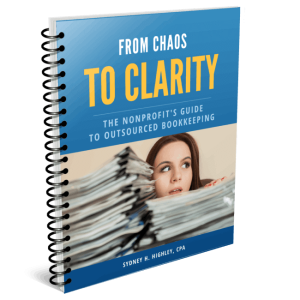
What You Need to Know About Financial Forecasting for Nonprofits
Despite its initial complexity, financial forecasting is a powerful tool that gives your nonprofit a clear vision of the future. It empowers you to plan for potential funding gaps, unexpected expenses, and growth opportunities. Regular forecasting enables your organization to allocate resources better, ensuring every dollar goes toward advancing your mission. It’s not just about the numbers—it’s about being proactive, staying flexible, and ensuring you’re prepared for whatever comes next. Effective forecasting keeps your nonprofit resilient, allowing you to focus on the work that matters most.
Want more? Keep reading…
Table of Contents
ToggleThe Importance of Financial Forecasting in Nonprofit Organizations
Creating a financial forecast is not just essential for nonprofits; it’s a strategic advantage. It provides key insights that help ensure stability and plan for long-term success.
Here’s why it matters.
It Ensures Financial Stability
Nonprofit organizations often face unpredictable funding sources, whether donations, grants, or government contracts. Forecasting helps nonprofits anticipate these fluctuations and plan accordingly, ensuring they can maintain core operations even when revenue streams vary.
Analyzing past trends and projecting future income help nonprofits make more informed decisions, ensuring financial stability.
It Helps Plan for Long-Term Sustainability
Financial forecasting allows nonprofits to think beyond immediate needs. Predicting future expenses and resources allows organizations to set realistic goals and ensure they have the financial capacity to achieve them.
The long-term view supports strategic planning and helps nonprofits avoid shortfalls that could disrupt their mission.
It Helps Cope With Change
Forecasting is about adaptability. Nonprofits can use these insights to pivot quickly during economic shifts, funding changes, or emerging needs, ensuring they stay on track to meet their goals and remain agile in a dynamic environment.
Key Components of Financial Forecasting for Nonprofits
Accurate forecasting involves key components that guide nonprofits in planning effectively.
Revenue Projections
Predicting future income can be challenging for nonprofits, as donations, grants, and sponsorships may fluctuate.
Financial forecasting helps organizations project these revenue streams by analyzing historical trends, donor behavior, and upcoming funding opportunities. Nonprofit organizations can better plan for expected income and anticipate shortfalls.
Expense Management
Nonprofits must also account for various expenses, including program costs, salaries, and overhead. Forecasting enables organizations to estimate these costs accurately, ensuring they can allocate resources effectively and avoid overspending on operational needs.
Balancing Revenue and Expenses
Effective forecasting ensures that a nonprofit’s revenue projections align with its expenses, helping maintain financial health. Balancing both help nonprofits continue to deliver impactful services while avoiding financial strain.
Steps to Creating an Effective Financial Forecast for Nonprofits
This section will explore essential steps for an effective financial forecast tailored to nonprofit organizations.
Step 1: Assess Revenue Sources
The first step in financial forecasting is evaluating all revenue streams. Nonprofits should analyze past donations, grants, and sponsorships to identify trends. Understanding the timing and reliability of these funds can help organizations anticipate future income.
Additionally, nonprofits should explore potential new funding sources, such as events, partnerships, or government grants, to diversify their revenue.
Step 2: Forecast Expenses
Nonprofits must project their expenses to allocate resources appropriately. Understanding these costs enables organizations to align their spending with their mission better, ensuring that resources are used efficiently.
Step 3: Adjust for Economic Changes
Economic fluctuations can greatly impact a nonprofit’s financial health. Incorporating trends such as inflation, recession risks, or changes in donor behavior allows nonprofits to prepare for financial challenges.
Community needs may also shift, requiring nonprofits to adjust their forecasts to stay relevant and responsive.
Step 4: Engage Stakeholders
Board members, staff, and key stakeholders are essential in creating accurate financial forecasts. Their insights can provide valuable context for understanding program priorities and operational needs.
Engaging them early ensures a more comprehensive view of the nonprofit’s financial future, promoting collaboration and shared responsibility. It means involving them in the data collection, analysis, and decision-making processes.
Step 5: Partner With an Outsourced Accounting Firm
Outsourcing accounting services can bring significant expertise to financial forecasting. These firms offer specialized knowledge in nonprofit accounting, helping to create more accurate, data-driven forecasts.
They can also assist with compliance, reporting, and risk management, ultimately enhancing the organization’s financial stability and growth. Their role is not just about number crunching but about providing strategic financial advice and ensuring the organization’s financial health.
Final Thoughts
Financial forecasting is vital for nonprofit stability and success. Evaluating revenue, predicting expenses, and adapting to economic shifts help nonprofits make informed decisions and align resources with their mission. A proactive approach helps nonprofits prepare for uncertainties and achieve their goals.
For expert financial support, contact us today for a free consultation!
Nonprofit Resources

About the Author
Syd Highley is a CPA and Managing Principal of Daily Balance, a nonprofit accounting firm located in Sacramento, CA. Offering virtual nonprofit bookkeeping services that take the place of an in-house accounting department, with the added benefits of financial audit representation and virtual CFO services, Highley empowers nonprofits to focus on their missions while saving up to 40% in accounting costs.






